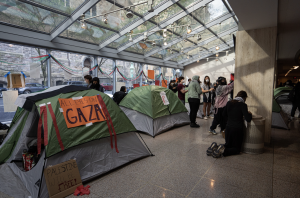Shifting the Focus Back to New Orleans, Three Years Later
The Physical and Psychological Effects of Hurricane Katrina Continue to Resonate Through the City
June 20, 2011
Published: April 2, 2009
Out of sight, out of mind. We hear this cliché so often that it seems to have lost its significance. The thoughts that are most active in our minds are those that directly connect to our immediate environment. If you do poorly on an exam, you toss the paper in the back of your desk drawer—out of sight, out of mind. Your boyfriend decides to attend a college that is far from yours and you find your relationship faltering—out of sight, out of mind. You read an article in the newspaper, hear more about it on the radio and see similar coverage on the television—in sight, in mind.
Media has incredible power as a gatekeeper of information. We know most information about the world beyond our immediate reach thanks largely to newspapers, Web sites, blogs, television and radio. Hurricane Katrina and its destructive aftermath were hot topics, timely and “newsworthy” in 2005, but how often do we now hear about the current status of the city, over three years later?
Stepping onto the plane in New York, leaving my little bubble behind, I had no idea what to expect when I touched down in New Orleans. I had spent nearly five months preparing for this trip with the rest of my Global Outreach team, but I still had multiple uncertainties. I was anxious about how the people in the community would receive our group—would it be with heartfelt appreciation, or would they see us as detached outsiders? Even more, I couldn’t recall the last time I saw a recent image of the city streets—were the houses mainly repaired and in living condition, or were roofs still collapsed and windows still boarded up? New Orleans had been out of my direct sight for so long that I couldn’t accurately visualize it in my head.
During my week-long stay, I realized how much Hurricane Katrina continues to haunt the city at every turn. The immense impact the storm and the levee failures had on the community is still heavy in the air.
As we drove through the city, I observed water lines up to 15 feet high from where the floodwater rested for three weeks before it finally receded. Windows remained boarded up, roofs were caving in and areas of were siding missing, leaving open gaps in homes. Most of these houses were abandoned, be it by resident death or relocation. Yet for many families, these seemingly unlivable and inhumane conditions are their only feasible option for shelter.
During the two days I spent helping to scrape and re-paint a home in the Upper Ninth Ward, I continually noticed a nearby house. Paint was peeling everywhere, the roof gutters were barely hanging on, window glass was broken and the wooden siding panels were missing from large breeches in the walls. At one point during my last day at this site, I happened to look over and see the figure of a man in a white t-shirt ironing in the back room. I still cannot believe that this is the place that he returns to at the end of each day and calls his home.
Driving through the city, I found myself constantly drawn to the spray-painted “Xs” on the front of the homes. These markings, left by rescue task forces after the storm, had the most profound impact on me. Each of the four spaces in the X indicated one piece of information: who was there, when, what dangers were found (gas off, toxic water, no entry) and how many bodies were found. Each day as I sat in the van on the way to and from the work sites, my eyes instinctively scanned the houses, mainly focusing on the bottom part of the X that signified the bodies found dead upon arrival. For the most part, I saw “0,” but then, with no warning, I would see a “1” or a “2.”
I once passed by a large, boarded-up school and read “128.” These are not statistics, these are lives lost to Katrina—children, grandparents, mothers and fathers. New Orleans is full of these ever-present reminders of both the physical destruction the storm wrought and the persistent psychological impact on the community. Imagine walking past what used to be your grandmother’s home, seeing a “1” in the lower spot of the X, knowing that digit stands for someone you loved all your life.
On a guided tour through the city, I asked our guide why there were so many X markings still showing. I found her response much more significant than she may have intended it to be. She told me that some residents keep the markings on purpose and that others try to cover them up with paint or scrub them off brick. For me, I interpreted this to mean that much of New Orleans wants to keep those Xs in sight, almost as a memorial to the lives lost and to sustain the memory of Katrina. Yet other survivors want to scrub off the symbol of destruction, perhaps because it is too painful a reminder of the loss of loved ones and the completely inefficient government response.
Even if people succeed in removing the X marking from their own doorsteps, the rest of the neighborhood streets still remain haunted by Katrina. They can pass by the levee in the Lower Ninth Ward that broke and caused the most severe damage, and they can see it has been rebuilt once again to its original, obviously inadequate height of 15 feet. They can notice the water lines on homes, and recall those three long weeks when the floodwater submerged 80 percent of the city. Although they can remove the X markings from their own homes, they can never undo the damage and loss of life that those letters and numbers represented. Katrina has become so entwined into the history and identity of the city. For New Orleans, it is impossible for Katrina to become out of sight and out of mind.
Back inside my little bubble in New York, it hasn’t been easy to explain to my friends why I chose to spend my Spring Break in New Orleans. Many don’t understand why volunteers are still needed there. My friends are not being ignorant; most simply haven’t heard about Katrina and its effect on New Orleans in over three years. So many other news stories have cropped up in that duration, all of them in constant competition for our attention.
Just because we do not hear about something doesn’t mean it doesn’t exist. Fortunately, the media is not the only way we learn about the world outside our little bubble. We also gain information from the people we encounter each day—friends, family, professors and even strangers. If the mass media are not relaying information about the present state of New Orleans and the lives of the people who call the city home, then all we can truly rely on are the personal stories of others. Although it has been extremely difficult for me to even attempt to verbalize my experience and realizations, I hope that my story will get through to some and inspire a shift in focus and motivation to take action. Yet still, I know that others may simply scan it or skip it altogether—out of sight, out of mind.












